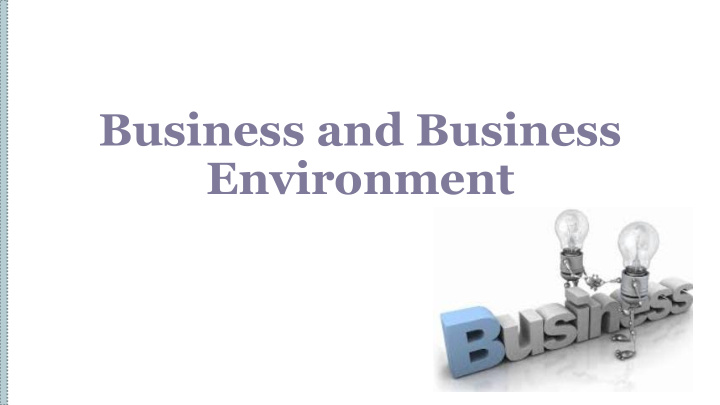



Business and Business Environment
Unit 03 – Use contemporary examples to demonstrate both the positive and negative influence/impact the macro environment has on business operations Lesson 05 : Market Forces and Economic Operations
Introduction to economics • Economics is a social science concerned with production, distribution and consumption of goods and services. • It studies how individuals, businesses, governments, and nations make choices on allocating resources to satisfy their wants and needs, trying to determine how these groups should organise and coordinate efforts to achieve maximum output.
Types of Economics • Micro economics – Focuses on the behaviour of individual consumers and producers : could be a household, a business organisation or a government agency. • Macro economics – Studies on overall economy on both national and international levels. Considers aspects of foreign trade, government fiscal and monetary policy, unemployment rates, the level of inflation and interest rates etc.
Wants, Needs & Economics • Need is something needed to survive – food, water and shelter • Want is one step up in the order from needs and is simply something that people desire to have, that they may, or may not, be able to obtain or means to fulfilling our needs. Unlimited wants Scarcity
Scarcity • Scarcity refers to the basic economic problem. • Gap between limited (scarce) resources and unlimited wants. • This results in people will have to make decisions on how to allocate the resources efficiently, to satisfy needs and as many additional wants as possible.
Opportunity cost • Opportunity costs represent the benefits an individual, investor or business misses out on when choosing one alternative over another. Opportunity Cost = Return on Best Forgone Option - Return on Chosen Option
Economic Systems
Factors of Production • Factors of production refers to the inputs those are necessary to obtain an output. • Land – Land has a broad definition as a factor of production and can take on various forms, from agricultural land to commercial real estate to the resources available from a particular piece of land. • Labour – This refers to the efforts expended by an individual to bring a product or service to the market.
Factors of Production • Capital – Capital refers to money, yet, this will not be directly involved in production. Capital will facilitate the processes used in production. • Entrepreneurship – This is the factor which combines all the other factors of production into a product or service for the consumer market.
Cadbury Chocolates – Video Analysis Answer the following questions using the learning from Cadbury Chocolate manufacturing video. 1) Explain the concept of scarcity. 2) Explain the concept of factors of production and identify the factors of production utilised in Cadbury chocolate manufacturing process.
Economic Systems The existence of economic scarcity poses three problems concerning the use of resources. 1) What to use the available resources for? That is, what goods and services should be produced (or not produced) with the resources? 2) How best to use those resources? For example, in what combinations, using what techniques and what methods? 3) How best to distribute the goods and services produced with them? That is, who gets what, how much and on what basis?
Economic Systems • Traditional economy • Command economy • Free market economy • Mixed economy
Traditional economy • These are economies those produce goods based on customs, values, traditions, beliefs or religion. These areas tend to be rural and not as concerned about making money as they are surviving. Characteristics: Examples: Pros: 1. Minimal waste • Inuit Cultures • Tradition is maintained Parts of Africa Each member of the society has a • • 2. Rural conditions • Parts of Latin America profound role 3. Little to no profit • Parts of Middle East Cons 4. Limited technology • Parts of Asia • Vulnerable to changes – example weather
Command economy • Command economies are economies those are typically controlled from one place, the government. Government makes all decisions on what and how much to produce. Government also decide values and pay. Pros: Characteristics: • Allows for regulation 1. Centralized power • Allows for growth 2. Government ownership of the means of production Cons: Examples: • Unfair to population 3. Usually socialist or communist • China Unrest may happen • • Cuba • Limited innovation Vietnam • • North Korea
Market economy • Market economies are hypothetical. A market economy is where all production and consumption is controlled by the markets of supply and demand. Factories only produce what will be consumed and the people want only what is produced. Pros: Characteristics: Seemingly perfect • Examples: • No regulation and taxes 1. Free market ideals • None Cons: • Zero governmental regulations 2. Zero government involvement
Mixed economy • Mixed economies are economies that are a combination of other economies, specifically, a combination of command and market. Mixed economies allow for private ownership and decisions, but government is still involved. Characteristics 1. Market more or less free of government Pros: 2. Some state run enterprises Allows for freedom • Examples: • Any one can be successful • USA 3. Individual liberties • Allows for innovation • Canada Cons: • UK • Government disputes • Japan Taxes • Many others •
THANK YOU!
Recommend
More recommend